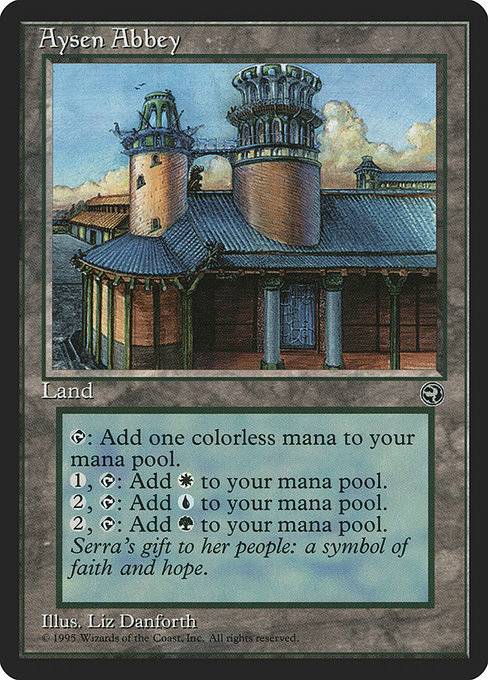
Image courtesy of Scryfall.com
Aysen Abbey: A Cult Favorite in the Homelands Era
If you’ve been roaming the halls of MTG nostalgia, you’ve probably heard whispers about Aysen Abbey—that unassuming land from Homelands that somehow became a cult classic 🧙🔥. Released in 1995, during a time when the mana base of your decks often felt like an adventure into the unknown, this little fixer stood out not for flashiness but for pure, practical versatility. The Abbey isn’t flashy in the way dual lands or splashy rares are, yet it carved a niche by being a three-color enabler in a set famous for its idiosyncrasies. And yes, there’s something delightfully poetic about a holy site that can generate colorless mana and still feed a White, Green, or Blue engine with the right taps and payments. It’s the kind of card that becomes a fan favorite not because it wins games outright, but because it quietly enables so many memorable turns 💎⚔️.
Why players latched onto its quirky power
Three things set Aysen Abbey apart from other lands of its era: flexible fixing, early ramp potential, and a flavor that resonates with Serra’s faith and hope. On the surface, it’s a land with no mana cost, which already makes it a smidge unusual for color-fixers of its time. The abilities read like a small toolkit you can pull from a pocket dimension:
- T}: Add {C} — a reliable, all-purpose mana buffer that helps you accelerate into your game plan without overcommitting your precious spells.
- {1}, T}: Add {W} — a straightforward way to reach White mana for early or mid-game plays, such as revealing your Crusade or arcane auras with tempo-friendly White spells.
- {2}, T}: Add {G} or {U} — this is the real clever bit. It gives you access to Green or Blue by paying a modest extra mana, enabling color-fixing or splash strategies in three-color shells that simply couldn’t be realized with more common lands of the era.
In practice, that means Aysen Abbey is a pivot card for players who loved multi-color collaboration before the world of modern fetchlands and shock lands existed in abundance. It isn’t about speed-demon combos; it’s about turning a land into a patient, gradual engine that lets you cast the right spells at the right moment. For three-color decks—especially those weaving White, Green, and Blue together—the Abbey provided a steady line of mana that could smooth out color access on the way to midgame finishes 🧙♂️🎲.
“Serra’s gift to her people: a symbol of faith and hope.”
The flavor text isn’t just lore fluff; it mirrors the card’s role on the battlefield. In the Homelands era, where players often built around powerful but temperamental themes, an Abbey that can help you reach White for a pair of chime-like angelic plays, while still granting access to Green or Blue later, felt like a piece of poetry you could actually play. The control-and-fix narrative fits the nostalgia for an era when colors learned to cooperate rather than simply race to the most efficient two-color pairing. And yes, the art from Liz Danforth, with its serene chapel atmosphere, reinforced that sense of faith and steadfastness that fans now associate with this quirky fixer 🧪🎨.
The cultural heartbeat of a set that’s often misunderstood
Homelands isn’t everyone’s favorite set—its mix of world-building ambitions and design experiments produced some memorable misfires as well as triumphs. Aysen Abbey stands as a bright spot in the conversation: a card that invites you to imagine a three-color strategy blossoming from a single, humble land. The audience that cherishes this card tends to be long-form MTG fans who relish crafting flavor-rich, offbeat decks, those who value mana geometry as a puzzle to solve, and players who collect the quiet heroes of the pre-1999 era. It’s not about the most thrilling finish; it’s about the journey—the long game where a land quietly enabling your W/U/G dreams becomes a signature moment in a match 🎭.
From vintage shelves to modern days: why it still matters
Even as the game grew into new eras with fetchlands, trilands, and labyrinths of mana costs, Aysen Abbey’s reputation endured because it captures a particular MTG mood: efficiency meets elegance in the most unassuming package. It’s the card that shows off how artful design can deliver practical payoff. For collectors and players alike, it’s a reminder that a single land from a quirky expansion can leave a lasting impression—an emblem of a time when players built around oddities and still found a way to win in surprising ways 🧙💎.
If you’re a curator of MTG setups who loves the tactile joy of turning a station into a storyline, you might enjoy pairing your board with gear that reflects that same spirit. This kind of sentiment is exactly what makes a card like Aysen Abbey feel timeless, and it’s part of why it remains a talking point in today’s conversations about mana fixing, color identity, and the Homelands era 🧭.
Editorial notes for the curious collector
- Set: Homelands (HML), expansion, 1995
- Rarity: Uncommon
- Colors: Color identity includes Green, Blue, White
- Legal formats: Commander, Duel, Premodern, and other legacy-era formats
- Artist: Liz Danforth
- Flavour and lore align with Serra’s blessing motif, a quiet beacon in a world of grand epics